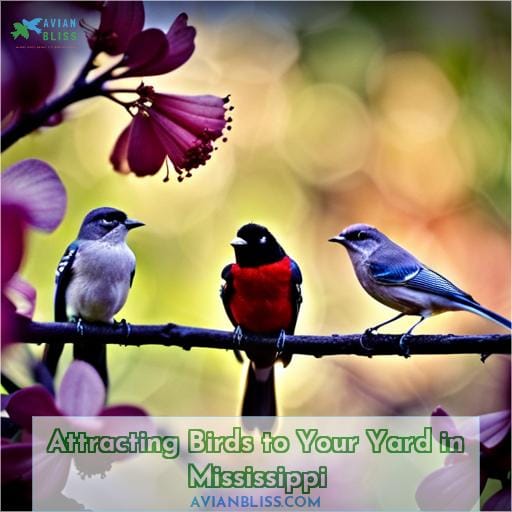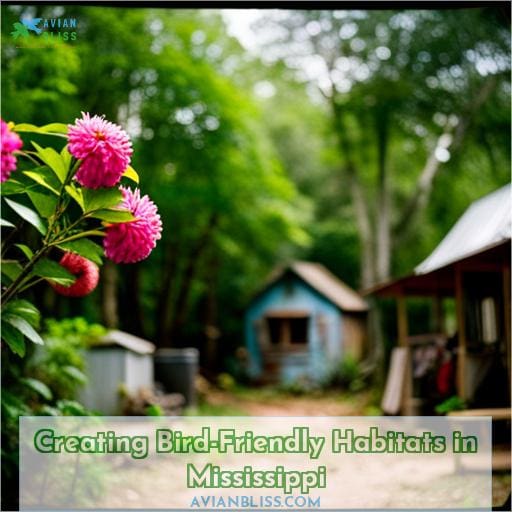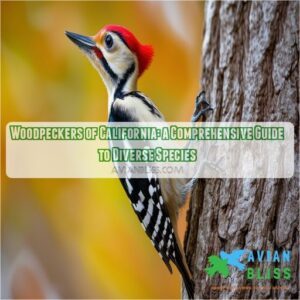This site is supported by our readers. We may earn a commission, at no cost to you, if you purchase through links.
 As you marvel at the birds flitting about your backyard in Mississippi, have you ever wondered which species are common in this area? The truth is that dozens of different kinds of birds call the Magnolia State home.
As you marvel at the birds flitting about your backyard in Mississippi, have you ever wondered which species are common in this area? The truth is that dozens of different kinds of birds call the Magnolia State home.
From Northern Cardinals and Blue Jays to Yellow-rumped Warblers and Northern Mockingbirds, it’s easy to spot a variety of avian life if you know where – and when – to look!
Here we’ll explore some of Mississippi’s most popular backyard birds, as well as offer tips on how to attract them into your own garden or yard.
So take out those binoculars: let’s discover more about these beautiful creatures who share our space here in Mississippi!
Table Of Contents
Key Takeaways
- Mississippi is home to over 300 bird species, with 221 species found in Jackson County alone.
- Common backyard birds in Mississippi include the Northern Cardinal, Blue Jay, Yellow-rumped Warbler, Northern Mockingbird, and Red-bellied Woodpecker.
- To attract birds to your yard, provide food, water, shelter, and nesting sites for them.
- Join local birding clubs and utilize resources such as eBird to track sightings and connect with fellow birding enthusiasts.
Common Backyard Birds of Mississippi
Backyard birding in Mississippi provides opportunities to observe both resident and migratory species throughout the year. From January through December, you can expect to see familiar visitors like the red Northern Cardinal, noisy Blue Jays, brightly colored Yellow-rumped Warblers, vocal Northern Mockingbirds, and acrobatic Red-bellied Woodpeckers coming and going with the seasons in your backyard habitat.
The Northern Cardinal’s bright red plumage makes it easy to spot, while Blue Jays stand out with their azure blue wings and tail. Listen for the repetitive Peter Peter Peter song of the Northern Mockingbird. Scan tree branches to catch a glimpse of energetic Red-bellied Woodpeckers as they climb up and down trunks.
With a little luck, you may spot a Yellow-rumped Warbler flitting through bushes, recognizable by its yellow rump patch. Providing food, water, and shelter can entice these visitors to become regulars at your backyard feeders and birdbaths.
Spending time watching these charming feathered friends is a relaxing way to connect with nature close to home.
Northern Cardinal
You’ll often spot the red male Northern Cardinal perched high in tree branches year-round, as this striking bird is the most frequently seen backyard visitor throughout Mississippi. Supplement its natural diet of seeds, berries, and insects by filling tube feeders with black oil sunflower seeds.
Plant native shrubs and trees to attract nesting pairs. Northern Cardinals appreciate brush piles, evergreens, and water features in backyards across Mississippi. With crest feathers and a red triangular beak, identify the male by his bright red plumage.
Blue Jay
Spotting a Blue Jay is always a treat – did you know that they’re known for their striking blue plumage and can mimic the calls of hawks to protect their territory? Here are some interesting facts about these charismatic birds:
- Noisy Intelligence: Blue Jays are highly intelligent and have been observed using tools, storing food, and even mimicking cell phones.
- Ventriloquial Skills: They have ventriloquial skills, which allow them to imitate other bird species‘ calls, making it difficult to locate them in dense vegetation.
- Favorite Foods: Blue Jays enjoy a varied diet, including nuts, seeds, berries, insects, eggs of other birds, and small vertebrates like frogs or lizards.
- Mississippi Birding Locations: Look for blue jays in wooded areas throughout Mississippi, such as forests, parks, and suburban areas with mature trees.
Remember to keep your eyes peeled for these common backyard birds during your bird-watching adventures! Don’t forget to use a bird identification app or consult eBird data for accurate identifications.
Happy spotting!
Yellow-rumped Warbler
Keep an eye out for yellow patches moving along branches as the yellow-rumped warbler arrives in September. These birds fly south from their northern nesting grounds to winter in Mississippi. Watch for them in trees, eating insects and berries. Their plumage provides camouflage among the yellow fall leaves.
To attract them, offer suet feeders with nuts and berries. Spotting yellow-rumped warblers signals the changing seasons.
Northern Mockingbird
Explore the diverse soundscape of your outdoor environment and you’ll likely hear the melodious songs of the Northern Mockingbird, as it effortlessly mimics other bird species. This fascinating behavior is just one aspect of this common resident in Mississippi.
The Northern Mockingbird also exhibits territorial behavior, defending its nesting area vigorously against intruders. When it comes to diet preferences, these clever birds have been known to eat a variety of foods including fruits, insects, seeds, and even small lizards or snakes if available in their habitat.
- The Northern Mockingbird’s ability to mimic other birds’ songs allows for an extensive repertoire that can include over 200 different melodies.
- These resourceful birds build their nests using twigs and grasses on trees or shrubs close to human habitation.
- They are highly protective parents who will aggressively defend their nest against any potential threats.
- While they primarily feed on insects during the breeding season when protein-rich food is crucial for raising young ones.
Overall, the adaptable nature and impressive vocal abilities make the Northern Mockingbird a delightful addition to any backyard birdwatcher’s list. By providing suitable habitats like dense shrubbery for nesting cover, and offering ample food sources such as berries, insects, suet, and seed blends, you can attract not only mockingbirds but also Carolina Wrens, American Robins, and House Sparrows.
Additionally, having strategically placed birdhouses could provide additional nesting opportunities, particularly for cavity-nesting species like wrens. For those seeking a deeper understanding, frequent observations coupled with eBird data tracking can help unravel more about these captivating songsters.
Red-bellied Woodpecker
Get ready to witness the striking red plumage of the Red-bellied Woodpecker as it hops and climbs through your outdoor sanctuary. This striking woodpecker is a permanent resident of Mississippi, delighting birders as it drills for insects or eats berries from fruiting trees.
Watch for its bold zebra-striped back, bright red cap, and the telltale red patch on its otherwise pale belly. To encourage woodpeckers, ensure old trees stand and dead branches remain for nesting and feeding sites.
With luck, the rat-tat-tat of a Red-bellied will become a familiar backyard rhythm.
Attracting Birds to Your Yard in Mississippi
With an abundance of food sources, shelter, and fresh water, you can easily transform your Mississippi yard into a birdwatcher’s paradise. Offer specialized tube, platform, and suet feeders alongside fruiting trees and shrubs, while also providing bird baths and nest boxes, to meet the needs of both resident and migratory birds that pass through the Magnolia State.
Mixing up feeder types and planting native fruiting flora draws in a diversity of species. Installing bird baths gives birds a place to drink, bathe, and cool down. Nest boxes satisfy nesting requirements for cavity dwellers like chickadees, nuthatches, and bluebirds.
By catering to the essential needs of food, water, shelter, and nesting sites, any Mississippi yard can become a haven for winged visitors.
Bird Feeders
Place recommended bird feeders like suet, peanut, platform, hummingbird, and ground stations in your yard to attract the birds of Mississippi. Position feeders near cover so birds feel safe eating and resting. Offer high energy, high fat foods for fall migrants and winter residents.
Clean feeders regularly to avoid disease and feed only high quality mixes. Sterilize the feeders as well. You’ll notice wintering sparrows, towhees and cardinals benefiting from this care. Come spring, observe courting behaviors at feeders as resident and transient species fuel up on migration.
Hummingbird Feeders
Hang nectar feeders filled with sugar water to entice hummingbirds to your yard. Use a 4:1 ratio. Keep the nectar fresh by changing it every few days, especially in hot weather. Clean feeders weekly using hot water and vinegar.
Place feeders in partial shade near flowering plants that provide habitat. Hang multiple feeders around your yard to minimize territorial conflicts. Observe hummingbird behaviors and migration patterns to best attract them during the seasons they inhabit Mississippi.
Consider DIY feeders, but ensure they’re thoroughly cleaned. Creating an inviting habitat will attract these energetic birds.
Food Sources
With autumn weather arriving, feed suet cakes in your hanging feeder to see brilliant Northern Cardinals flock to the treat. Providing quality bird food sources tailored to species in your area can make your yard a hub of bird activity.
- Black oil sunflower seeds for cardinals, titmice, finches, sparrows, jays
- Safflower for chickadees, titmice, cardinals, grosbeaks
- Suet for woodpeckers, nuthatches, wrens, chickadees
A variety of fresh, high-energy foods will satisfy nutritional needs and invite birds to feast.
Fruit-bearing Plants
You’re oh so right, cherry trees and blackberry bushes make for mighty fine additions to any yard in Mississippi. Growing fruit-bearing plants like native blackberries, elderberries, serviceberries, or wild grapes will attract plenty of birds looking for food.
Eastern phoebes, white-eyed vireos, and eastern kingbirds love feasting on the berries. Barn swallows scoop up insects drawn to the fruit. Even brown-headed cowbirds will stop by to snack. Offering up backyard fruit trees and bushes gives birds the natural, nutritious foods they desire.
Nut-bearing Plants
Planting oaks, beeches or dogwoods lets you achieve two benefits with a single action by providing tasty nuts and habitat for Mississippi’s backyard birds. These native tree species not only offer a reliable food source for the avian residents but also create ideal environments for nesting and roosting.
By incorporating these nut-bearing plants into your wildlife gardening efforts, you can enhance backyard biodiversity and attract various bird species like chimney swifts, American crows, and red-winged blackbirds in regions such as Jackson or Hattiesburg.
Nectar Plants
Experience the joy of seeing bright, happy birds fluttering around your yard as you offer them sweet nectar from beautiful flowers. Plant selection is key when creating a bird-friendly garden. By incorporating native species and designing a pollinator garden, you can attract not only birds but also butterflies and bees.
Choose nectar-rich plants like purple coneflowers, sunflowers, and trumpet honeysuckle to provide an abundant food source for these delightful creatures. Avoid invasive species like European starlings that compete with native birds for resources.
Shelter and Cover
Milkweed and brush piles attract birds by offering concealment. Intelligent landscaping attracts birds seeking shelter. Appeal to nesting preferences with native plants like milkweed for food and materials.
Integrate dense shrubs and evergreens for cover. Append birdhouses to provide cavities for nesting. Brush piles give ground birds refuge. Considerate yard design sustains the full lifecycle, satisfying instincts for security and reproduction.
Nest Boxes
You can set out some nest boxes if you’d like more cavity-nesting birds. Providing nesting sites will entice breeding pairs to raise young in your habitat. Build boxes designed for the species you hope to attract. Proper placement and ongoing maintenance are key for occupancy.
With a good nest box program, you’ll enjoy the sight of fledglings taking their first flights come spring. Target Eastern bluebirds, Carolina chickadees, tufted titmice, and woodpeckers. Your efforts will be rewarding.
Fresh Water
Setting out clean water daily will lure thirsty birds to quench themselves in your yard. Birds need water for drinking, preening, and cooling down. Offer fresh water in a shallow birdbath or plant saucer.
Include features like dripping water, stones for perching, sloped sides, and smooth edges.
- Attracts more bird species
- Provides hydration
- Creates a backyard oasis
- Offers avian water sources
- Is important for bird health
Providing fresh water can bring in rare migrants stopping by just for a drink or bath.
Identifying Birds in Mississippi
When identifying birds, examine the size and shape of the body along with the tail, bill, and wings. Also take note of distinct color patterns on the head, back, belly, wings, and tail, as well as behaviors like feeding, nesting, and flocking that offer clues.
As an avid birder in Mississippi, I’ve learned to pay close attention to subtle details like the shape of a beak or the flash of a wing to distinguish between similar species. Factoring in size, colors, patterns, behaviors, and habitat has helped me identify everything from tiny hummingbirds to soaring raptors that pass through the state.
Size and Shape
Though shape and size help in recognizing birds, watchful eyes pick apart all nuances. To identify birds, observe body and wing shape. Longer wings mean stronger fliers. Notice tail shapes like notched, rounded, or forked tails. Short tail shapes imply agility.
Assess leg length for perching or walking birds. Body mass signifies seed eaters or wide-ranging hunters. Subtle variations in form reflect function. Learn the patterns of nature’s purposeful designs.
Color Patterns
Take note of the distinct color patterns on a bird’s head, back, belly, wings, and tail when trying to identify it.
- Feather identification: Look for specific colors and markings on different parts of the bird’s body.
- Plumage diversity: Birds display a wide range of plumage colors and patterns.
- Camouflage strategies: Some birds use color patterns to blend into their surroundings or attract mates during breeding season.
- Breeding season colors: Many birds exhibit vibrant or unique coloration during mating seasons.
By paying attention to these details, you can enhance your ability to identify different bird species based on their distinctive color patterns.
Behavior
Observe how they interact with each other, listen to their songs, and watch their unique behaviors as they flit from branch to branch. Despite their small size, backyard birds display intriguing behavior. In spring, males perform elaborate mating dances and songs to attract mates, while later both parents work diligently to construct nests and raise their young.
In fall and winter, to survive the harsher months, they adapt to food scarcity by flocking together and even visiting feeders near homes. Though subtle initially, the habits of familiar backyard birds reveal their complex lifestyles upon closer inspection.
Distinctive Features
You’ll notice the colors of their heads, backs, bellies, wings, and tails as you identify birds in Mississippi. Pay close attention to plumage features while bird watching. Note the bird’s size, shape, colors, and patterns.
Examine the bill, wings, tail, and body shape. Use apps and data from eBird to aid in identification. Distinctive markings are key to matching a bird to an illustrated guide. With practice, you’ll recognize common backyard visitors and appreciate their beauty.
EBird and Birding Communities in Mississippi
eBird, the premier bird-sighting resource, allows you to find illustrated checklists and recent sightings near you. At the same time, you can connect with passionate local birders through the American Birding Association to enhance your backyard birding experience.
When utilizing county data from popular birding hotspots in Hattiesburg and Jackson, keep in mind that both resident and migrant bird populations may double during travel seasons.
Using EBird for Bird Sightings
By checking eBird regularly, you would find updated lists of birds spotted near you in Mississippi. Scanning the recent sightings gives you insight on species diversity and numbers in your county. The bar graphs reveal the most frequently reported birds each week. Reviewing eBird’s illustrated information prepares you for local birding.
Before heading out, study the latest reports to discover prime birding locations and rare sightings. Using filters helps you identify seasonal changes, arrivals, departures, and rarities to expand your life list.
Joining Local Bird Groups
Step up and get familiar with fellow backyard birdwatchers through walkie-talkies for avian chat sessions. Your local Audubon chapter offers weekly bird walks, monthly meetings, and field trips. Share sightings, photos, and tips. Meet at parks, refuges, and farms. Learn together to better identify birds and find rare species.
Help with surveys, counts, and banding. Protect habitats and advocate for nature.
Accessing County-specific Data
Utilize eBird’s county atlases to understand the bird populations unique to your locality within Mississippi.
- Explore distribution maps for all recorded species in your county.
- View bar charts showing relative abundance over time.
- Find birding hotspots and recent notable sightings.
- Compare your county’s trends to statewide data.
- Learn which species breed, winter, or migrate through.
Knowing your county’s avifauna intimately allows you to contribute meaningful data as a citizen scientist while becoming a more skilled birder. By using eBird’s powerful county-level data, you tap into the collective sightings of the birding community to inform your efforts.
Creating Bird-Friendly Habitats in Mississippi
The habitat in your yard determines which birds will be present, so provide food, water, and shelter to attract the most common species. Use specific feeders and foods to meet birds’ needs. Native fruiting shrubs and trees offer natural food sources, so plant some.
Use eBird to discover all the bird species possibilities in your area. Join a local birding club to enrich your experience.
Importance of Habitat
You’ll attract more birds once you plant some fruiting shrubs for natural foods. Birds need suitable habitat to thrive.
Native plants provide food and shelter. Leave dead trees and brush for nesting and cover.
Row crops lack habitat diversity. Support habitat preservation initiatives. Restore degraded habitats.
Urban planning should optimize wildlife resources through thoughtful placement of green spaces, wetlands, and forest fragments.
| Food Sources | Water Sources | Shelter Sources |
|---|---|---|
| Native fruiting shrubs and trees | Birdbaths | Dense shrubbery |
| Berry plants | Water features | Evergreens |
| Seed bearing grasses and flowers | Rain gardens | Brush piles |
| Suet feeders | Wetlands | Cavity trees |
| Seed feeders | Creeks | Nest boxes |
| Nectar feeders | Marshy areas | Long grass |
| Vegetable gardens | Fountains | Hedges |
Attracting Common Birds
Your habitat will bring in the Northern Cardinals with ample sunflowers while bluebirds happily nest in provided boxes.
- Offer a variety of feeders like tube, platform, and suet to target different species.
- Use fruiting shrubs and trees for natural food sources.
- Include both sun and shade areas in landscaping.
- Avoid pesticides that could be harmful to birds.
- Provide brush piles as shelter.
Seeing familiar birds drawn to the habitat you created connects you to the natural rhythms around you.
Planting Native Fruiting Bushes and Trees
Plant cherry, serviceberry, elderberry, and oak trees to offer the birds natural forage. Songbirds thrive on native fruits like blackberries, dogwoods, and hollies. Habitat gardening supports wildlife while curbing invasives.
Embrace ethical landscaping. It nurtures birds, pollinators, people, and the planet.
Utilizing EBird for Species Information
Utilizing eBird, Mississippi hosts over 300 bird species throughout the year with 221 species spotted in Jackson County alone.
- View recent sightings to find birding hotspots and rare birds.
- Explore bird distribution maps and abundance graphs.
- Download checklists and keep track of your life list.
- Participate in birding challenges like Global Big Day.
- Share photos and sounds to help with research.
eBird is a remarkable tool for learning more about the incredible diversity of birds across Mississippi.
Joining a Local Bird Club
Joining a local birding club allows you to connect with fellow bird enthusiasts and gain valuable knowledge about attracting birds to your area. Becoming part of a community of local birders lets you share sightings, get help identifying species, and learn the best techniques for creating an enticing habitat in your yard or neighborhood.
Birding groups organize educational talks, field trips, and conservation projects that fully immerse members in the world of birdwatching. Tapping into the collective expertise of seasoned birders helps you better understand the patterns and behaviors of birds that live in or migrate through your region.
Participating in club activities supports important conservation efforts and gives you a sense of community with others who share your passion for birds.
Conclusion
With the right habitat and food sources, you can easily attract a variety of backyard birds of Mississippi to your yard. From Northern Cardinals to Blue Jays, Yellow-rumped Warblers and Red-bellied Woodpeckers, there’s plenty of birds to observe and enjoy.
To attract these beautiful birds, consider providing bird feeders, hummingbird feeders and food sources such as black oil sunflowers, millet, corn, peanuts and suet. Plant fruit-bearing plants, nut-bearing trees and nectar plants, and provide shelter and cover for birds to nest.
Offer fresh water for drinking and bathing and install nest boxes to create a perfect bird-friendly environment. With a little patience and effort, you can make your backyard an oasis for backyard birds of Mississippi.







